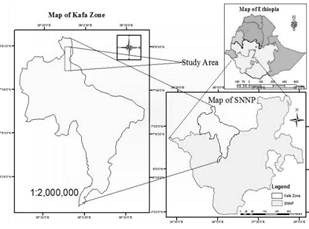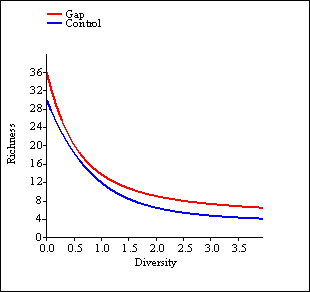Introduction
Forest canopies are in a dynamic condition and changing continually1. The major dynamic in forests canopies constitutes the death of canopy trees that result in the formation of forest gaps and subsequent regeneration of tree seedlings. The formation of gaps result in changes microclimatic conditions of forests especially, light, moisture and temperature which favor establishment of shade intolerant seedlings2. The tree regeneration triggered by gaps are a fundamental process of forest dynamics and plays a key role in maintaining forest structure, composition, and diversity of forest ecosystems1. Natural disturbance is among the major phenomenon that result in canopy gaps formation3,4. Particularly, Afromontane forests are subject to a wide range of disturbances of variable duration, intensity, and frequency4. The presence of gaps associated with mechanism is also important in forest ecosystem restoration5,6. The incidents portray the death of one or more canopy trees or fall of large branches that resulted in the formation of small openings on the canopy of forests2.
Gap formation depends on several physical and biological factors involving canopy closure, intensive growth of advanced regenerations and species colonization7. It passes through diverse stages, but the most important stage is the initiation stage known as gap stage8. This stage contributes in altering light availability, to enhance seedling and sapling establishment among species, which otherwise blocks most light from reaching the forest interior9. Gaps help to maintain the tree diversity, density and niche partitioning10. Thus, regeneration processes are associated with gap building phase7. The occurrence particularly interplays with recruitment, allowing the coexistence of species that otherwise could not make it11,12. Finally, construction stage took place where the canopy gaps are forming virtually closed by tree vegetation12.
Size distribution and frequency of gap occurrences in a forest is a function of local climate, topography, soil, bedrock and the composition and size distribution of trees10. This is the result of the shift in microclimate near and below the ground, such as light intensity, temperature and drought stress at the soil surface, as gap size. The micro-climatic features of a canopy gap might change with its size from one season to another, and even with extreme climate events. These conditions may be optimal for certain species at a certain point in time, though they can change in a mid/long term13. Some plant species can only regenerate in a narrow range of light availability14. In addition to the marked variation in the canopy opening, the reduction of basal area and the increase in gap-area found in canopy gaps that can also interfere in the process of regeneration and in the growth of tree seedlings15.
The colonization of gaps by species of different categories or successional groups are influenced by eco-physiological responses16. Moreover, it will also depend on the time the opening has occurred, the opening size, the substratum conditions, and the relationship with herbivores as well as on density dependent factors. In restricting population growth, a density-dependent factor intensifies as the population size increases, affecting each individual more strongly17. Understanding the dynamics of gaps in tropical forests is paramount for forest restoration, sustainable management and conservation of forest remnants18. This study aims to analyzing regeneration patterns of woody species in a natural gaps of Kafa Afromontane forest.
Materials and methods
Location. This study was conducted in Kafa Afromontane forests, found in Kafa Zone, Gimbo and Gawata Districts, located at 450 km west of the capital Addis Ababa. The area lies between 60 16ǁ - 8013ǁN latitude and 350 12ǁ - 36047ǁE.
Longitude locations. The zone borders Benchi Maji zone in the west, Ilubabor zone in the north, Sheko zone and Jimma zone in the east. The area is characterized by a long rainy season that extends from March through October with mean annual rainfall of 1800 mm. The area has a relatively higher temperature in the months December to February with maximum temperature that ranges from 26o to 29o C and the mean annual temperature of the area is 19o C19. Kafa zone lies within the altitudinal range of 1400 to 1650 masl. Forests of this area are characterized as moist Afromontane forest, which is situated in areas that receive rainfall for a longer period. The biggest trees of this forest community reach up to 40 m in height. Common trees in this area include Pouteria adolfi-friederici, Ficus species, Syzygium guineense, Olea welwitschii and Trilepisium madagascariense.
Methods. The actual field study was conducted from 15 March 2019 to 30 May 2019. For the purpose of this study a forest with an area of 4 ha, (200 x 200 m) plot was selected systematically inside the main forest blocks of Kafa forest one plot at each of the three sites (Yeyibto, Achewa and Saja). These sites are within two districts (Gimbo and Gewata). Inside these plots identification of natural gaps were made along four transacts laid 50 m apart from each other. Gap detection was made during field observation when encountered wood debris, broken branches, snapped off trees or dead canopy tree boles which have over 10 m long and created an area of over 40 m2 following20. The species, Diameter at breast height. original height and type of damage of gap former trees were determined or estimated1,20. The longest distance between any two-canopy trees i.e. gap length and the largest distance perpendicular to the length (gap width) were measured for each gaps encountered. Distances from the centre of the gap to the edges of the gaps was measured in eight compass directions, namely 0, 45, 90, 135, 180, 225, 270 and 315 and a sketch map of the gap was drawn. Ellipsoidal shapes can approximate many gaps. Therefore, the area of each gap was calculated by the ellipse formula following21, where: A -is gap area, L- is the longest width and W -is the longest perpendicular distance.
Gap former trees were categorized based on the category set as standing dead, tree fall by snapping off, tree fall by uprooting, broken branch/crown and branch fall22. Measurements of collar diameter and heights of all woody seedlings and saplings were made in five sample plots of 3x3 m, which was set up one at the center and four-border area of the gaps. Similarly, measurements were made inside four plots (3x3 m) in control plots outside gaps separately which were used for comparison. The measurement was used for comparison of seedling located in the extended gap zone of a canopy gap (‘gap’ seedling) and under a closed forest canopy (‘forest’ seedling) following23.

Figure 2 Some of the causes of gap formation in Kafa moist Afromontane forest (a- broken branch, b- snapping off and c-standing dead)
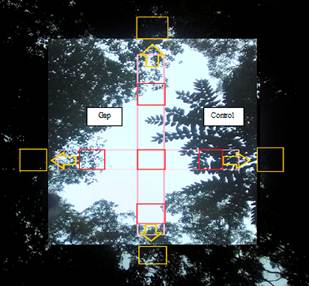
Figure 2a Some of the causes of gap formation in Kafa moist Afromontane forest (a- broken branch, b- snapping off and c-standing dead)
The data was summarized using Microsoft excel and Paleontological Statistics Software Package for Education and Data Analysis Version 4.03 (PAST) and thus species richness, species diversity, species evenness and frequency distribution of height classes were calculated as follows:
Species diversity of regeneration of woody species in gaps and control plots was calculated using the Shannon-Wiener diversity index, H, as:
Where H′ represents Shannon-Wiener diversity index and pi represents proportion of individuals found in the ith species.
Species richness (S) was calculated as where ni is the number of species in a community
Shannon equitability (J) or evenness was calculated using the following formula:
Where J is the evenness, H′ is the Shannon-Wiener diversity index, and Hmax′ = lnS, in which ln is the natural logarithm and S is the total number of species in the sample.
The turnover time of the forest was calculated by dividing the total studied area by the total area covered by gaps created during the last year. This way, an estimate of the total number of years necessary to cover the entire plot with gaps (turnover time), was obtained24.
Resultados
Gap sizes. The size and frequency of gaps are important parameters that vary by location and nature of gap maker trees. The areas of the gaps were calculating by using the ellipse formula. Thus the result showed gap sizes ranged from 75 to 555 m2 with the mean gap size of the study area is 223.31 m2 with standard deviation of 152.14 m2 (Table 1). Most of the gaps had an area that falls <200 m2 (57.1 % n=8) of the gaps. While four gaps (28.6 %) were grouped as in gap size class, 200-400 m2 On the other hand, gap size which has an area of >400 m2 was the least encountered (14.3 %, n=2) each gap size class in the forest. Generally, the size distributions of the gaps showed sleekness to the left.
Table 1 Area of different gaps and their relative frequencies
| Category | Area class | Mean area in (m2) | Number of gaps | Percentage (%) |
|---|---|---|---|---|
| Small | < 200 | 117 ± 42 | 8 | 57.1 |
| Medium | 200-400 | 289 ± 61 | 4 | 28.6 |
| Large | >400 | 513 ± 59 | 2 | 14.3 |
| Mean | 223 ± 152 |
Table 2 Gap former tree species in Kafa moist afromontane forest and number of gaps
| Gap maker tree Species | Average Dbh (cm) | Average Height (m) | Number of gaps | Percentage (%) |
|---|---|---|---|---|
| Olea welwitschii | 47.12 | 29.9 | 5 | 35.71 |
| Prunus Africana | 55.00 | 28.0 | 2 | 14.29 |
| Schefflera abyssinica | 77.50 | 29.5 | 2 | 14.29 |
| Syzygium guineense | 32.00 | 21.0 | 2 | 14.29 |
| Ehretia cymosa | 24.00 | 35.0 | 1 | 7.14 |
| Elaeodendron buchananii (Loes) | 74.00 | 26.0 | 1 | 7.14 |
| Polyscias fulvia | 24.00 | 35.0 | 1 | 7.14 |
Gap maker species. Gap makers are the trees that initially fell to create gaps. These species were identified during field collection by looking the intact leaves when available and recognized remnants. Hence, gap maker species includes O. welwitschii, Ehretia cymosa, Polyscias fulvia, Prunus africana, S. guineense, Schefflera abyssinica, and Elaeodendron buchananii (Loes). The largest proportions (36 %) of gaps were created by O. welwitschii (Table 2). This species is also the most dominant tree species in the forest area.
Causes for gap formation. The major causes of gap formation in the study area were caused due to four reasons, which include snapping off, uprooting, broken branches and standing dead. Among these snapping of accounts (43 % n=6) of the causes of gap formation (Table 3).
Table 3 Causes of gap formation in Kafa afromontane forests south west Ethiopia
| Cause of gap formation | Frequency | % age |
|---|---|---|
| Standing dead | 1 | 7.14 |
| Snapping off | 6 | 42.86 |
| Uprooting | 3 | 21.43 |
| Brocken branch | 4 | 28.57 |
| Total | 14 | 100.00 |
Broken branches constitutes (29 %, n=4) and uprooting and standing dead constitutes 21 and 7 % respectively.
Table 4 Comparison of Diversities of Kafa afromontane forest in gaps and control plots
| Parameter | Gap | Control | p-value |
|---|---|---|---|
| Number of species | 36 | 30 | 0.001 |
| Number of seedlings | 11274 | 7974 | 0.000 |
| Dominance | 0.121 | 0.127 | 0.034 |
| Shannon H | 2.643 | 2.599 | 0.012 |
| Evenness e^H/S | 0.390 | 0.448 | 0.001 |
| Simpson indx | 0.879 | 0.873 | 0.034 |
The gaps and gap surrounding areas sampled species, their families, successional characterization and number of individuals are listed in (Table 5). The thirty-six species recorded during this study were categorized in to families. Thus, the three families with great species abundance were Rubaceae represented by six species, Fabaceae three species and Moraceae three species. The three dominant families Rubaceae, Fabaceae and Moraceae accounts for about 40 % of the total species abundance recorded during this study. Out of all tree families, only eight of them were represented by more than one species while the rest 13 families were represented by a single species (Table 5).
Table 5 Plant Families with their number species occurred in Kafa afromontane forest
| S/N | Family | Species number per site | Total | % age | ||
|---|---|---|---|---|---|---|
| Yeyibto | Achewa | Saja | ||||
| 1 | Rubiaceae | 6 | 5 | 3 | 6 | 17.14 |
| 2 | Fabaceae | 2 | 2 | 3 | 3 | 8.57 |
| 3 | Moraceae | 2 | 1 | 3 | 8.57 | |
| 4 | Asteraceae | 1 | 1 | 2 | 5.71 | |
| 5 | Celastraceae | 1 | 1 | 2 | 5.71 | |
| 6 | Meliaceae | 1 | 1 | 2 | 2 | 5.71 |
| 7 | Oleaceae | 2 | 2 | 1 | 2 | 5.71 |
| 8 | Sapindaceae | 1 | 1 | 1 | 2 | 5.71 |
| 9 | Aquifoliaceae | 1 | 1 | 2.86 | ||
| 10 | Araliaceae | 1 | 1 | 1 | 2.86 | |
| 11 | Boraginaceae | 1 | 1 | 2.86 | ||
| 12 | Euphorbiaceae | 1 | 1 | 1 | 2.86 | |
| 13 | Icacinaceae | 1 | 1 | 1 | 1 | 2.86 |
| 14 | Melianthaceae | 1 | 1 | 1 | 2.86 | |
| 15 | Myrsinaceae | 1 | 1 | 2.86 | ||
| 16 | Myrtaceae | 1 | 1 | 2.86 | ||
| 17 | Pittosporaceae | 1 | 1 | 1 | 2.86 | |
| 18 | Rosaceae | 1 | 1 | 1 | 2.86 | |
| 19 | Rutaceae | 1 | 1 | 1 | 1 | 2.86 |
| 20 | Sapotaceae | 1 | 1 | 1 | 1 | 2.86 |
| 21 | Ulmaceae | 1 | 1 | 2.86 | ||
| Total | 26 | 21 | 17 | 35 | 100 | |
There were 35 species of woody seedlings; belonging to 21 families recorded in 14 gaps and at three sites (Table 5). The number of tree species recorded in control plots is about 30 species. As shown in Table 4 the gap area has higher density of 11274 stems per hectare as compared to 7974 in control plots which showed significant difference (p<0.001). Besides there is also difference in species richness (36) in canopy gaps as compared with (30) species in control plots. Evenness of the area was found to be 0.390 and 0.448 for gaps and control plots respectively. Shannon diversity of 2.643 for gaps and 2.599 for control plots. Simpson index of 0.879 for gaps and 0.873 for control plots (Table 4).
Table 6 Dominant tree seedling abundance in Kafa Afromontane forest inside gaps and control plots
| Scientific name | Gap Regeneration | Control Regeneration | ||
|---|---|---|---|---|
| N | Relative density (%) | N | Relative density (%) | |
| Chionanthus mildbraedii | 3030 | 29.9 | 2377 | 32.8 |
| Rothmannia urcelliformis | 1785 | 17.6 | 579 | 8.0 |
| Elaeodendron buchananii (Loes) | 883 | 8.7 | 691 | 9.5 |
| Oxyanthus speciosus | 837 | 8.2 | 725 | 10.0 |
| Deinbollia kilimandscharica Taub | 574 | 5.7 | 671 | 9.3 |
| Allophylus abyssinicus | 509 | 5.0 | 355 | 4.9 |
| Albizia gummifera | 448 | 4.4 | 235 | 3.2 |
| Vepris dainellii | 376 | 3.7 | 421 | 5.8 |
| Galiniera saxifraga | 336 | 3.3 | 204 | 2.8 |
| Pouteria adolfi-friederici | 311 | 3.1 | 231 | 3.2 |
| Lepidotrichilia volkensii | 256 | 2.5 | 127 | 1.8 |
| Bersama abyssinica | 243 | 2.4 | 135 | 1.9 |
| Prunus Africana | 201 | 2.0 | 77 | 1.1 |
| Millettia ferruginea | 199 | 2.0 | 181 | 2.5 |
| Oxyanthus speciosus | 160 | 1.6 | 243 | 3.4 |
| Total | 10148 | 100.0 | 7252 | 100.0 |
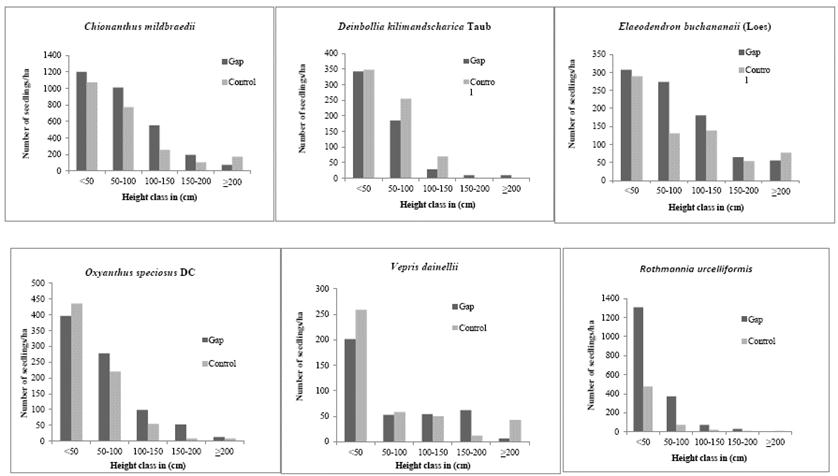
Figure 4 Height class distribution of seedlings and saplings of the six dominant species in gaps and control plots of Kafa afromontane forest
The patterns of height class distribution indicate the general trends of population dynamics and recruitment processes of a given species. The evaluation of selected tree species reveals six main patterns of population distribution. Species such as Cordia africana, Vernonia auriculifera, and Ilex mitis were only recorded in gaps. Whereas, species like Ekebergia capensis, Lepidotrichilia volkensii, and Maesa lanceolata were specialized to control plots. The rest majority of the species were recorded in both gaps and control plots.
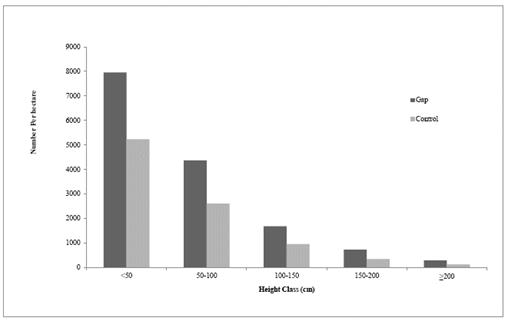
Figure 5 Height class distribution of seedlings and saplings of the communities in gaps and control plots of Kafa afromontane forest
The height class distribution of the seedlings growth inside gaps and control indicates that the number of individuals in the lower height class is very high (Figure 4). The lowest numbers of individuals were found in the height class of >200 cm increasing with decreasing height. The number of individuals in the gaps is higher than in the closed forests (controls). The population structure regenerating seedlings in the gaps and control plots almost follows a similar trend.
Discussion
Gap size is mainly responsible for variation of light intensity, which plays a major role in forest regeneration. According to Dirzo et al. 25, the influence of gap size on light environment is important in understanding the dynamics of communities. Based on the calculations using the ellipse formula gap sizes ranged from 75 to 555 m2 with the mean gap size of the study area is 223.31 m2 with standard deviation of 152.14 m2 (Table 1). Most of the gaps had an area that falls <200 m2 (57.1 % n=8) of the gaps. The study revealed that number of small size gaps are more than large size gaps.
The species identified as gap makers include, O. welwitschii, E. cymosa, P. fulvia, P. africana S. guineense, S, abyssinica and E. buchananaii (Loes). These species are dominant in the forest area and occupied the upper story of the forest. As well, the upper story species could be exposed to the wind damage that could result in gap formation O. welwitschii represented the largest proportions (36 %) of gaps among the identified gap former tree species (Table 2).
The major causes of gap formation include; snapping off, uprooting, broken branches and standing dead. These factors are the major cases in many studies. Snapping off accounts the largest share (43 % n=6) of the causes of gap formation (Figure 4). For example, the study by Arihafa & Mack6 in a tropical rainforest of Papua New Guinea also showed that higher probability of gaps formations due to boles snapping off than uprooting of trees followed by broken branches that constitutes (29 %, n=4). Uprooting and standing dead were the least causes and represents only 21 and 7% respectively. The deaths of trees happen because of aging and natural phenomenon such as lightening.
Regenerations of seedlings were counted in both gaps and closed forests. The result revealed that, the three most abundant families identified in the study area were Rubiaceae (6 species), Fabaceae (3), and Moraceae (3). The regeneration of the three dominant families alone contributed about half of the total species. Out of all tree families, only eight of them were represented by more than one species while the rest 13 families were represented by a single species (Table 4). Many studies also reveal the prominence of Rubiaceae and Fabaceae families in forest gaps compared to other families18.
The height class distribution indicates the general trends of population dynamics and recruitment processes of a given species (Figure 4 and 5). That showed high recruitment of seedlings and certain number of seedlings18. C. africana, V. auriculifera and Ilex mitis were recorded in gaps, while, species like E. capensis, L. volkensii, and M. lanceolata were specialized to control plots or outside the gaps. The remaining species were recorded in both gaps and control plots.
The study of gaps regenerations in Kafa Afromontane forest revealed that natural gaps caused by single tree or multiple trees fall are essential for maintaining the diversity of woody species in the forest. The mode of mortality was mainly related to snapping off the canopy trees (Table 3). Variations in the gap sizes were observed due to factors such as mode of death of the canopy trees. Regeneration in the forest is low in closed forest as compared to the gaps. The study of gap dynamics was not carried out in Kafa Afromontane forest before. Therefore, the current study of gap dynamics could provide some information on aspects of gap woody species regeneration in Kafa forest. In general, this study provides some of the firsthand information on the structure and composition of woody species regenerations of Kafa Afromontane forest where such data can be used in planning sustainable management of the forest. The longer term studies are also needed to elucidate the species specific survival and growth strategies related to gap openings.












 uBio
uBio 

